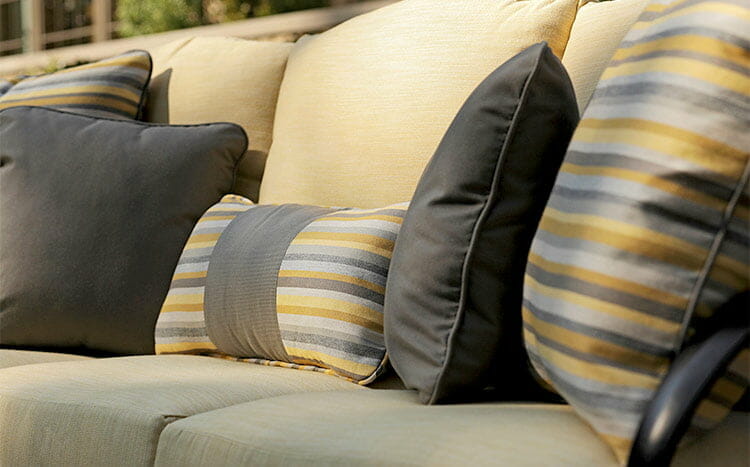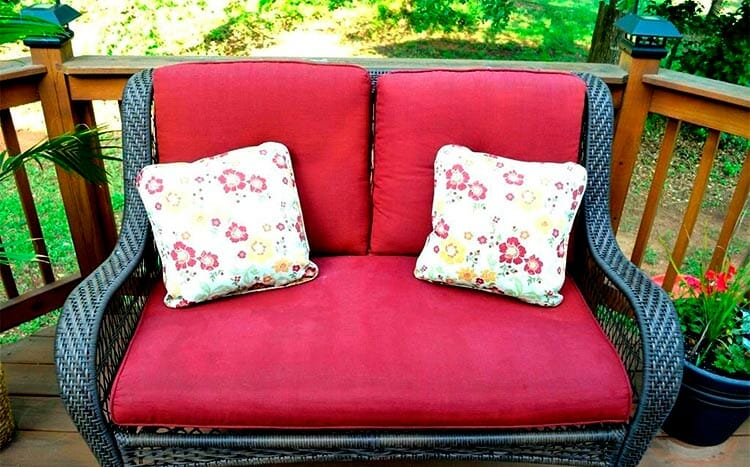Before you start using your outdoor cushions for the upcoming spring season, it’s smart to inspect them beforehand for any signs of mold.
Mold quickly grows on furniture both indoors and outdoors, especially if left out on the patio during winter. The good news, however, is that mold can be easily removed with just some water, soap, and sometimes, a little bleach.
Here is a step-by-step guide that you can follow to remove any mold infestation on your patio cushions.
What we cover
ToggleStep 1: Remove the cushions and wash machine the cases

First, remove the pillows from the furniture and unzip the cushion cases (if they have a zip). Run the cases through the washing machine just like you would any other laundry. You can add at least a cup of white vinegar to the wash water to ensure that any molds in the cushion cases are eliminated.
Tools and supplies you’ll need
- Vacuum cleaner
- Undiluted white vinegar
- Spray bottle
- Liquid dish soap
- Bucket
- Towels
- Scrubbing brush
- Sponge
- Washer dryer
- Garden hose
- Fabric protector
- Borax
For this and any other cleaning project you have involving vinegar or bleach, ensure you have some protective gear, e.g., hand gloves, face mask, and eye protection glasses. Also, never use bleach and its products if you’re pregnant.
Step 2: Vacuum the cushion, then spray with undiluted vinegar
Once your cushion cases are clean, turn to the cushions and first get rid of any loose debris or dirt on the surfaces using the vacuum upholstery attachment. For tufted cushions, be sure to vacuum properly over the crevices and seams.
If you don’t have a vacuum, you can also use a dry cloth to remove as much debris as possible.
Next, take an empty spray bottle, clean it and fill it with diluted white vinegar. Spray it to the front and back surfaces of the cushions, then let it rest for about 10 minutes.
Step 3: Soak, then hand-wash the cushions
Take your liquid dish soap and some sponge, then soak your cushions with the solution. Let the solution sit on the cushions for around 15 minutes. It’s preferable if you’d use warm water for this.
Scrub both the front and back sides of the cushions with the scrub brush until no stains are visible.
In the presence of mildew, add ¼ cup of borax to the solution, then spray it on the cushions. Depending on the mold infestation rate, apply more of the solution, then scrub gently on the high impact area. Repeat this until it’s clean.
Step 4: Rinsing and drying
When you’re satisfied with your scrubbing, it’s time to rinse the cushions. Use a soft, damp cloth to wipe dry or hose clean the cushions, but avoid using a lot of pressure.
Some people try pressure washing their cushions but only end up damaging the fabrics.
Once it’s clean, use a towel to absorb much of the water from the cushion, then let it air dry. You can also use your hairdryer to ensure that there’s no moisture left that could lead to mold regrowth.
Step 5: Protect your cushions
On successful completion of the mold removal process, you now have to ensure mold never comes back.
The first thing you should do is spraying your cushions with white vinegar again. The vinegar kills off any mold spores that might be left and helps eliminate the musty mold smell. Ensure you let the vinegar air dry as well.
Another thing you should do is protect your cushions using a fabric protector. These products resist stains and dirt accumulation on your cushions and also make them very easy to clean.
Due to their constant exposure to weather elements, try to clean your cushions at least once or twice a week.
Other ways to remove mold from patio cushions

Using bleach
Regardless of what you’ve heard, bleach always seems to work against mold, in this case, on mold on cushion surfaces.
To do this, you’ll need:
- Spray bottle
- Bleach (Chlorine or Oxygen)
- Gallon of water
- Soft-bristled Scrub brush
- Dry cloth and towels
- Vacuum cleaner
First, you’ll have to vacuum the cushion to get rid of debris and other dirt on the cushion surface. Next, mix about a half cup of bleach with a gallon of water, then spray the solution on the cushions using a spray bottle.
Note that chlorine bleach should only be used for white fabric cushions and oxygen chlorine for colored fabrics.
Let the solution sit on the cushion for around 10 minutes, then scrub it clean with a scrub brush.
Once it’s clean, rinse the cushion with warm water, then take a towel or dry cloth and soak up the excess water on the cushion.
Finally, let it air-dry and apply a fabric protector, or spray some vinegar to prevent mold from growing back.
Using Borax
Borax is a mineral that’s a common ingredient in most cleaning products. It kills mold quickly and also helps in getting rid of the mold smell.
To use it, you’ll need:
- Borax
- Water hose
- Coarse-bristled scrub brush
- Dish soap
- Bucket
The first step is soaking your cushions with water from your garden hose. Next, mix a cup of borax with some water and dish soap in your bucket.
Now use your brush to apply the solution on the wet cushions and scrub it on the affected areas until it’s clean. Let it sit for around 10 minutes.
Take the garden hose again, and now rinse the cushions until all the soapy solution is removed.
Use a dry towel or cloth to dry the cushion, or press it down to remove that excess water. Finally, leave it outside to dry under the hot sun.
Using Ammonia
Ammonia is another solution that’s effective in fighting molds on your patio cushions.
To use it, you’ll need:
- Ammonia
- White vinegar
- Baking soda
- Scrub brush
- Warm water
- Lint-free cloth
Your first step will be removing dirt on the cushion surface then handwashing or machine-washing the removable cushion cases.
Next, mix a cup of ammonia with ¼ cup of baking soda and a ½ cup of white vinegar with a gallon of water. Dip a lint-free cloth on this solution and apply it over all the affected areas of the cushion.
Do this until the mold stains on your cushion fabrics start to disappear. You can also use a toothbrush to scrub small mold-infested surfaces of the cushion.
Once it’s clean, rinse it with warm water and then use a towel or dry cloth to absorb the excess moisture. Finally, leave it to dry outside.
Important: Never use ammonia with bleach. The combination produces a dangerous fume that’s poisonous to your health.
FAQ's
Is vinegar or bleach better for killing mold?
Vinegar is a better mold remover. The problem with using bleach in removing mold is that bleach only removes the surface mold. It doesn’t get through to the real mold membrane that grows deep in a material and allows the mold to spread.
So, mold will eventually grow back after using bleach. In fact, the EPA doesn’t recommend using bleach as a mold remover unless under the supervision of mold removal professionals.
Distilled White Vinegar is a powerful remover because it can effectively remove mold both on the surface and the membranes retreating deeper in a porous material. It takes just about an hour to eliminate mold on any surface.
Can you just power wash patio cushions?
You can, but it may not be useful when you’re dealing with a mold infestation. Power washing is a quick and easy way to clean the cushions, getting rid of any dust or dirt.
However, many manufacturers discourage its use on their cushions because the high pressure destroys the fabrics.
Power-washed cushions also take a long time to dry. This means that mold could easily start growing again before it’s completely dry.
The best way to wash your patio cushions would be using a soft-bristled brush, water, and some liquid soap. If you must power wash, use lower water pressure and don’t stand too close to the cushions.
How do you remove mildew from patio cushions?
Removing mildew from your cushions isn’t very different from removing mold. All you need is some water, hose pipe, borax, a scrub brush, and detergent. First, mix about ¼ cup of borax with water and use a spray bottle to spray it on your cushions.
Let it sit on the cushions for about ten minutes, then use the scrub brush to clean the cushions. Finally, hose down your cushions until they’re clean.
For cushions with acrylic fabrics, mix bleach with some detergent, then repeat the process.
Can I protect fabric from mold?
Yes! Once you’ve gotten rid of mold from your patio cushions, there are several ways to prevent them from coming back. The most obvious way is by regular cleaning, and keeping your furniture dry to ensure the fabrics remain free of moisture.
You can also use mold and mildew repellant sprays such as a waterproof silicone spray. Look for a spray made for your cushion’s fabric and let it dry well under the sun.















